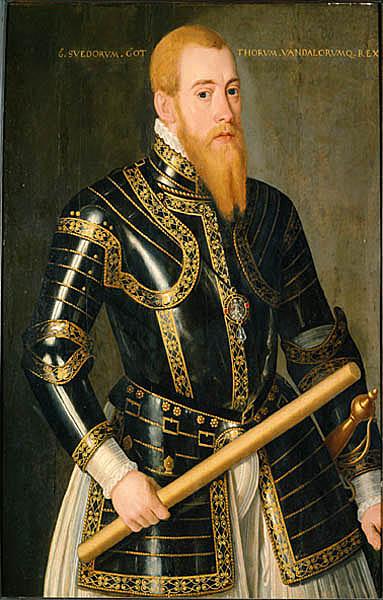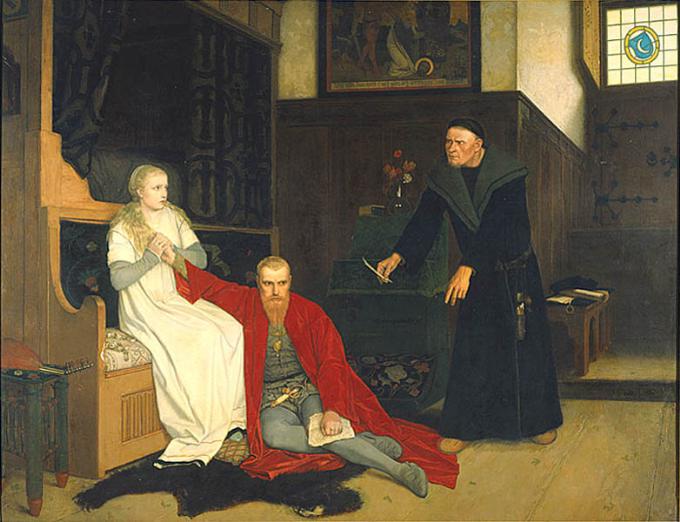<Back to Index>
- Physicist Franz Ulrich Theodor Aepinus, 1724
- Dramatist Carlo Gozzi, 1720
- King of Sweden Erik XIV, 1533
PAGE SPONSOR


Eric XIV, Swedish: Erik XIV (13 December 1533 – 26 February 1577) was King of Sweden from 1560 until he was deposed in 1568. Eric XIV was the son of Gustav I (1496 – 1560) and Catherine of Saxe - Lauenburg (1513 – 1535). He was also ruler of Estonia, after its conquest by Sweden in 1561.
While he has been regarded as intelligent and artistically skilled, as well as politically ambitious, early in his reign he showed signs of mental instability, a condition which eventually led to insanity. Eric suffered from schizophrenia and some scientists claim that his illness burst out early during his reign time and others think that he became sick after the Sture murders. However the psychiatrists who diagnosed him as schizophrenic did not question what the sources said about the king. When Eric XIV was deposed it was important to make sure everybody understood that he was not fit to be king. Today historians have questioned the truth of the sources of the slander of Eric XIV. Eric, being deposed and imprisoned, in all probability was murdered with arsenic. An examination of his remains in 1958 confirmed that it can safely be assumed he died of arsenic poisoning.
He had been crowned as Eric XIV, but it has been disputed and considered unlikely that he actually was the 14th king of Sweden named Eric. He and his brother Charles IX (1604 – 1611) adopted numerals according to a mythological History of Sweden. None of the Swedish kings named Eric before this one, of which there have been at least seven, are known to have used numerals. An unsubstantiated saga about the first known of the mythological Swea chieftains named Eric has been staged by some authors in the early 5th century A.D..
Eric XIV was born at Tre Kronor castle, at 9 o'clock in the morning on 13 December 1533. Before the age of two he had lost his mother and his father remarried Margaret Leijonhufvud (1516 – 1555), a Swedish noblewoman, in 1536.
Eric's first teacher was the learned German Georg Norman, whose services were shortly thereafter needed elsewhere within the Swedish state. He was replaced by French Calvinist Dionysius Beurreus (1500 – 1567). Dionysius taught both Eric and Johan and seems to have been appreciated by both. Eric was very successful in foreign languages and mathematics. He was also an informed historian, good writer and familiar with astrology.
When Eric started to appear in public he was referred to as the "chosen king" (Swedish: utvald konung) and after the parliament meeting in Stockholm 1560, he received the title of "hereditary king" (Swedish: arvkonung). In 1557 Eric was assigned the fiefdoms of Kalmar, Kronoberg and Öland and he took up residence in the city of Kalmar.
Eric went against his father's wish and entered into marriage negotiations with Princess Elizabeth Tudor (later Queen Elizabeth I of England 1533 - 1603).
Tensions between Eric and his father grew. He pursued Elizabeth for
several years but abandoned the attempts after his trip to England was
interrupted by the death of his father in 1560. Eric also made
unsuccessful marriage proposals to, among others, Mary, Queen of Scots (1542 – 1587), as well as Renata of Lorraine (1544 – 1602), Anna of Saxony (1544 – 1577) and Christine of Hesse (1543 – 1604). In domestic politics Eric's ambitions were strongly opposed by the Swedish nobility, including his half - brother, the later John III of Sweden (1537 – 1592).
John was the duke of Finland and he was married to a Polish princess
which in turn made him cooperate with Poland. John pursued an
expansionist policy in Livonia (Nowadays Estonia, Latvia and Lithuania)
which led to contention between Eric and his brother. In 1563 John was
captured and tried for high treason by order of Eric. Eric's foreign policy was
dominated by his efforts to make Sweden a great power. Unlike his
father, who had in general been satisfied with ruling an independent
state, Eric tried to expand his influence in the Baltic and in Estonia. This expansionism made him clash with his cousin, Frederick II of Denmark (1534 – 1588). Most of Eric XIV's reign was then dominated by the Scandinavian Seven Years' War against
Denmark (1563 – 70), during which he successfully repelled most Danish
attempts of conquest, but was not able to keep his own conquests.
During these years, from 1563 onwards, his insanity worsened; his reign
became even more arbitrary and marked by violence, among them the
killing of several members of the Sture family
in 1566. Eric himself stabbed the family member Nils Sture in 1567 and
then the conflict with the nobility came to its climax. The reason to
his bloody act were the suspicions of high treason from the Sture
family. Eric probably thought about this act as an execution and not as
murder. After the Sture homicide John was imprisoned, but in the fall of 1568 the dukes and the nobles rebelled, and Eric was dethroned. Eric was then imprisoned by duke John who took power. Eric's most trusted counsellor, Jöran Persson (1530 – 1568),
took much of the blame for the actions taken against the nobility
during Eric XIV's reign and was executed shortly after John III
ascended to the throne. Eric
XIV was held as a prisoner in many different castles in both Sweden and
Finland. He died in prison in Örbyhus Castle: according to folklore, his final meal was a poisoned bowl of pea soup.
A document signed by his brother John III of Sweden and a nobleman,
Bengt Bengtsson Gylta (1514 – 1574), gave Eric's watchmen in his last
prison authorization to poison him if anyone tried to release him. His
body was later exhumed; forensic analysis revealed evidence of lethal arsenic poisoning. Eric XIV had several relationships before his marriage. With Agda Persdotter he had four daughters. With Karin Jacobsdotter one child. Eric XIV finally married Karin Månsdotter (1550 – 1612), on 4 July 1568. They had four children. Through this family the blood line has been traced to a particular family line of Elomaa, currently living in Hamina, Finland.